The final journey: It’s come a long way
The final journey in memorable style – even if the dear-departed may not be wowed by the stately and sombre procession, for the kith and kin, the friends and acquaintances and even the bystanders it will be unforgettable.
‘Standing’ solemnly in the front-yard of the ‘oldest’ funeral directors of the country, the cynosure of all eyes, is the ‘newest’ sleek ebony and ivory pair in all their grandeur.
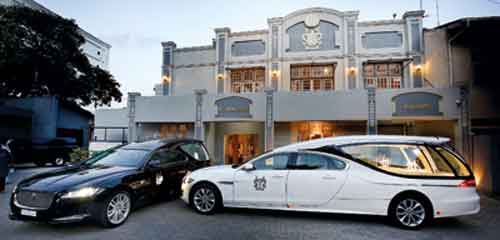
The two beauties: The black and white Jaguar hearses. Pix by M.A. Pushpa Kumara
Jaguar XF hearses!
It is in the elegant home of the Chairman of A.F. Raymond, Aubrey, the third generation of ‘The Firm’ which trails as far back as 1885 into history that we pore over dog-eared files with frayed edges and sepia-toned photographs of those early days, before going up the road to the office to gaze in wonder at their latest addition.
“This is another first in our silent service to the nation,” smiles Aubrey, seated at the head of his long dining table while wife, Marie and sons Johann and Shannon, chip in with details of the ‘final journeys’ which began with the humble hand-cart in 1885, then horse-drawn carriages, followed by motorized hearses with regular upgrades.
Now, in November 2017, the latest addition is the ‘mother’ of all hearses, a Jaguar Aurora and a Jaguar Grand Aurora, both ‘hand-made’ by a coach-builder in Venice, Italy, with Johann stressing that their ultra-efficient 2-litre Ingenium engines keep emissions low, while delivering power discreetly to make the journey smooth. The low emissions make it eco-friendly in an era when the harsh vagaries of the weather due to climate change are causing immense harm to the environment.
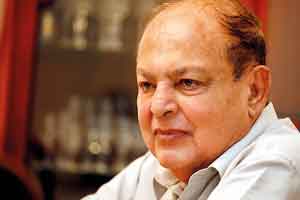
Chairman: Aubry Raymond
“This is an exclusive service, like many other trailblazing services we have been offering in the 132-year existence of A.F. Raymond,” says Johann, with Shannon adding that Jaguar hearses are not found anywhere in the country or in many other nations, not even in Singapore or Australia. The exceptions are the United Kingdom and others in Europe. “We usually set the norm in an effort to give the best to our clients and then others follow suit.”
Dad Aubrey laughingly adds that they were also the first to run an ambulance and have a hearse as part of an old crocks rally.
We travel in reverse gear to early times covered in misty shrouds, through precious documents and photographs preserved by The Firm down the ages. “There was no mechanization linked to the funeral service in the days of yore, with the cortege being led by a church ‘vehicle’ which was a hand-cart. Next came the horse-drawn funeral carriage,” says Johann giving us a glimpse of what it was like then.
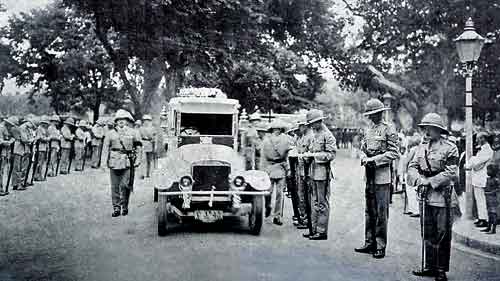
From the Raymond archives: Hearses from the past
World War I in 1914, however, changed that forever, with “horseless carriages” taking to cart-tracks which had metamorphosed into roads. With the 1918 Armistice and the war surplus enriching Ceylon, on the streets appeared cars and trucks. It was then that The Firm of undertakers and, in turn, Ceylon and also the region got its first motorized hearse.
Thumbing through the files, Aubrey, who has been with the Firm since 1958, delves into the details: The first motorized hearse that they imported was from Germany, but built in America. “It was a Kissel with the No. X263,” he says, showing us another Kissel hearse parked close to an undertaker’s shop on a London street.
The line of vehicles is held up for us to see – hot on the wheels of the Kissel followed the Fords, with Aubrey saying that they always imported the hearses in pairs of black and white. The Hindus like white hearses, he murmurs, speaking with decades of experience in the funeral business.
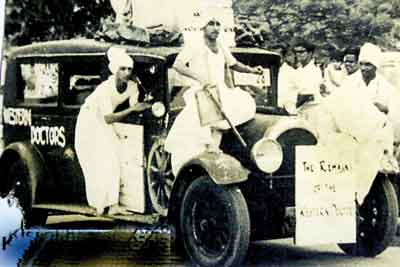 With the 1970s under Prime Minister Sirimavo Bandaranaike being foreign-exchange tight and having import-restrictions, the family running The Firm would keep a keen eye out for station wagons doing the rounds within the diplomatic corps which would be put up for sale at government auctions.
With the 1970s under Prime Minister Sirimavo Bandaranaike being foreign-exchange tight and having import-restrictions, the family running The Firm would keep a keen eye out for station wagons doing the rounds within the diplomatic corps which would be put up for sale at government auctions.
“The Firm’s very first custom-made hearses were left-hand drive Fords out of America,” says Johann, adding that later, the company moved into custom-made Volvo hearses in the 2000s. The company’s success in Sri Lanka, directed Volvo to sell hearses not only in Singapore but also in Australia.
Aubrey says that as the prices of Fords became exorbitant, they looked towards the east in general and Japan in particular for their vehicles. His mind also goes back to a square Volvo they utilized in their funeral processions.
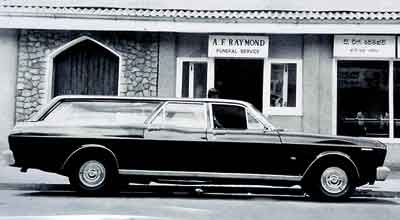 The time to change the hearse is indicated by the vehicle itself, he says, pointing out that whenever it starts throwing up little sputters, they get the message.
The time to change the hearse is indicated by the vehicle itself, he says, pointing out that whenever it starts throwing up little sputters, they get the message.
Usually, the ‘end is nigh’ signal comes on in about seven years…….and luxury replacements have now arrived, exuding more comfort and opulence.
An employee at A.F. Raymond waxes eloquent on the technology including how the Jaguar hearses have air-pressure sensors. They have no spare-wheels because the tyre air-pressure system keeps a check and if the air-pressure drops warns the driver early, enabling the fixing of the problem.
The coffin-trays are semi- automated, he adds, as we peek overawed into the 6-metre black Jaguar and the 6.5-metre white Jaguar lit up in their splendour, as the evening shadows lengthen into night, just across from the General Cemetery, Kanatte.


